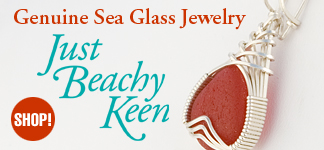
Many of the displays are in front of windows to allow the natural daylight to illuminate the glassware.
A Colorful History of American Glass
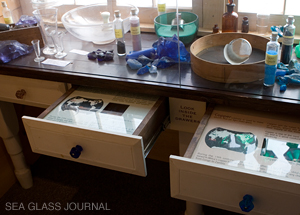
Also displayed in the Color & Chemistry Room are some of the minerals used to create the colors in the glassware along with information on where they were mined.
Sandwich Historical Society & Glass Museum, Cape Cod, MA
In Sandwich, MA, the oldest town on Cape Cod, a treasure exists that the avid sea glass collector should plan to visit. The Sandwich Historical Society's Glass Museum houses some of the finest examples of early American glassware in the country. The knowledge gleaned here can certainly help in the appreciation and identifying the origins of some of the older and more colorful sea glass shards a hunter may fortunately discover.
In 1825 Deming Jarves, a Boston businessman and former agent of the New England Glass Company of East Cambridge, MA, founded a small glass factory in Sandwich. Conditions for glassmaking were favorable in this area as local forests provided an abundance of trees that powered the furnaces of the factory. In 1826 his new enterprise was incorporated as the Boston & Sandwich Glass Company.
Story continues below...
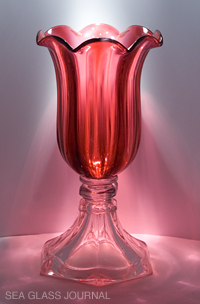
A glass vase using chemist James Lloyd's highly secretive ruby red recipe that included using gold.
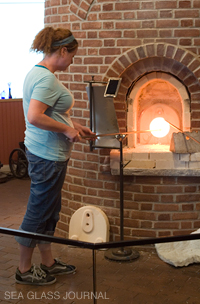
A 20-minute glassblowing demonstration is held every hour. Any questions will be answered there after.
In Sandwich, MA, the oldest town on Cape Cod, a treasure exists that the avid sea glass collector should plan to visit. The Sandwich Historical Society's Glass Museum houses some of the finest examples of early American glassware in the country. The knowledge gleaned here can certainly help in the appreciation and identifying the origins of some of the older and more colorful sea glass shards a hunter may fortunately discover.
In 1825 Deming Jarves, a Boston businessman and former agent of the New England Glass Company of East Cambridge, MA, founded a small glass factory in Sandwich. Conditions for glassmaking were favorable in this area as local forests provided an abundance of trees that powered the furnaces of the factory. In 1826 his new enterprise was incorporated as the Boston & Sandwich Glass Company.
Jarves employed glassblowers from Great Britain and the glassworks in East Cambridge, MA. Such skilled craftsmen served apprenticeships of up to seven years as they learned to manipulate hot glass into its desired forms. The output from the factory included wine glasses, decanters, bowls, dishes and other decorative tableware as well as lamps, chandeliers and vases.
Today, glassware from the Boston & Sandwich Glass Company is highly sought after by antique dealers and collectors alike, and the Society's Glass Museum remains dedicated to the preservation, study and display of Sandwich glass.
"Today, glassware from the Boston & Sandwich Glass Company is highly sought after by antique dealers and collectors alike."
The museum exhibits nearly 5,000 pieces of glass produced at the glass company between 1825 and 1888. Displayed in cases and in front of windows is glassware in clear or vivid colors shaped in simple as well as intricate forms. Along with the permanent exhibits there are also exhibits of contemporary glass artists and the museum gift shop.
Of particular interest to the sea glass collector is the museum's Color & Chemistry Room. Here you will find examples of glassware produced in Sandwich along with information on what minerals were used to create the colors. Some of the glass colors included are cobalt blue, canary yellow, deep amethyst and ruby red. You will also be able to listen to an audio account by the glass factory's chemist James Lloyd ( the voice is actually his great grandson ) of the travails of creating these innovative colors. Please note: the room is small so be careful not to knock over the chalk board!
Also take time to attend the 20-minute glassblowing demonstration held every hour. Any collector who has found very old sea glass shards will appreciate the effort and skill involved in creating the original glassware of early America. There is a question an answer period after the demonstration.
If you are an avid sea glass collector your time will be well spent exploring this gem of a museum. The museum is open daily 9:30 am to 5:00 pm. In order to see everything the museum has to offer it is recommended that you plan to be here no later than 3:30 pm.
For more information please go to Sandwich Glass Museum.
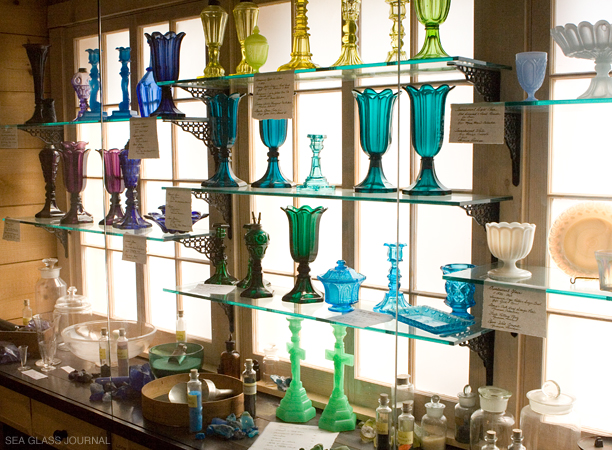
The Color & Chemistry Room displays many of the more exotic colored glassware produced by the Sandwich Glass Company along with an audio demontration by the factory chemist, James Lloyd, about the highly competitive business of creating these colors.
REFERENCES:
1. A Century of Sandwich Glass, Sandwich Glass Museum, 1992





